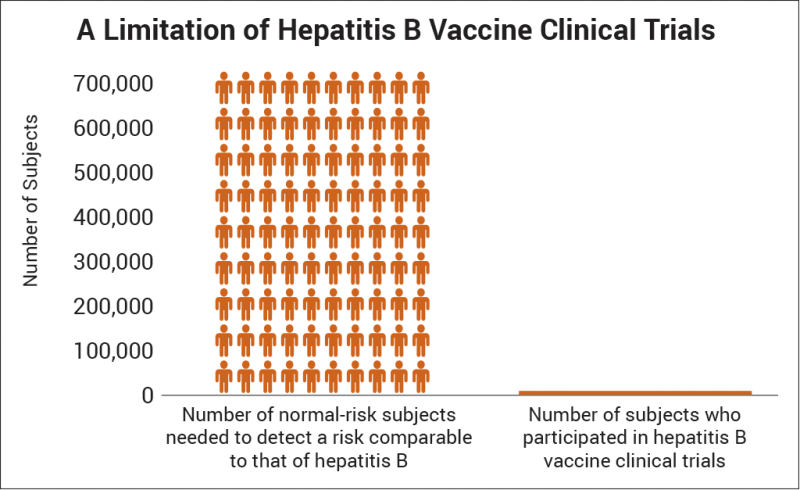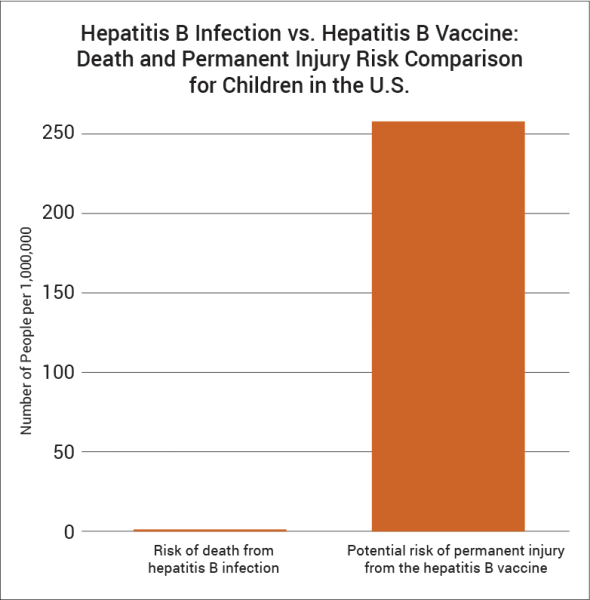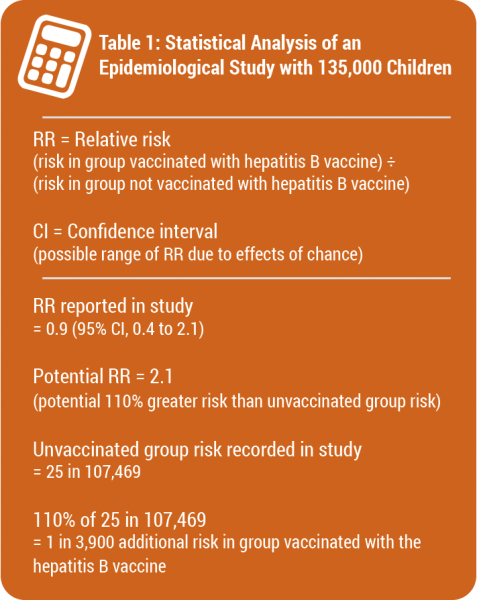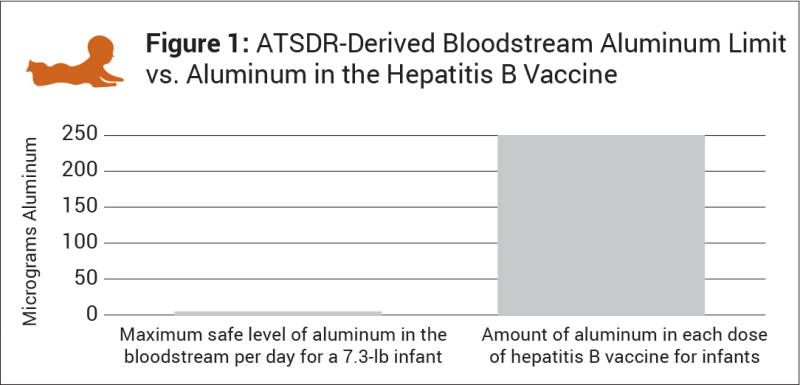Hepatitis B Vaccine: Is It Safer Than Hepatitis B?

1. WHAT IS THE HEPATITIS B VACCINE?
The hepatitis B vaccine was introduced in 1981 for use in high-risk populations, and then in 1991 it was used for mass vaccination of infants. It has significantly reduced the incidence of reported cases of acute hepatitis B infections; however, about 50% of vaccinated children lose their immunity by age 5,1 and the vaccine has not made a measurable impact on the prevalence of chronic hepatitis B infection.2,3
 2. WHAT ARE SIDE EFFECTS OF THE HEPATITIS B VACCINE?
2. WHAT ARE SIDE EFFECTS OF THE HEPATITIS B VACCINE?
Common side effects of the hepatitis B vaccine include fever, diarrhea, and fatigue/weakness.4 A more serious potential side effect is seizure, which may occur in about 1 in 1,300 children vaccinated with the hepatitis B vaccine.5-8 Although severe adverse events have been observed following hepatitis B vaccination, including neurological disorders (e.g., encephalitis, transverse myelitis, optic neuritis, multiple sclerosis, and Guillain-Barré syndrome) and autoimmune diseases (e.g., systemic lupus erythematosus, rheumatoid arthritis, and type 1 diabetes), the Institute of Medicine (IOM) states that “the evidence is inadequate to accept or reject a causal relationship between hepatitis B vaccine” and those conditions.9 For children, the hepatitis B vaccine contains 250 mcg of aluminum. This amount is 75 times greater than the maximum safe level of aluminum in the bloodstream per day for a 7.3-pound (3.3-kilogram) infant, derived from the Agency for Toxic Substances and Disease Registry (ATSDR), a division of the U.S. Department of Health and Human Services (HHS) (Fig. 1).10 Additionally, the manufacturer’s package insert states that the hepatitis B vaccine has not been evaluated for its “carcinogenic or mutagenic potential,” or its potential to impair fertility.4,11
3. HOW ARE RISKS OF VACCINE SIDE EFFECTS MEASURED?
Methods to measure vaccine risks include surveillance systems, clinical trials, and epidemiological studies.
 4. HOW ACCURATE IS SURVEILLANCE OF SIDE EFFECTS FROM THE
4. HOW ACCURATE IS SURVEILLANCE OF SIDE EFFECTS FROM THE
HEPATITIS B VACCINE?
The government tracks reported cases of vaccine side effects through the Vaccine Adverse Event Reporting System (VAERS). Approximately 114 cases of permanent injury and death from the hepatitis B vaccine are reported to VAERS annually.12 However, VAERS is a passive reporting system — authorities do not actively search for cases and do not actively remind doctors and the public to report cases. These limitations can lead to significant underreporting.13 The Centers for Disease Control and Prevention (CDC) states, “VAERS receives reports for only a small fraction of actual adverse events.”14 Indeed, as few as 1% of serious side effects from medical products are reported to passive surveillance systems.15 In addition, VAERS reports are not proof that a side effect occurred, as the system is not designed to thoroughly investigate all cases.16 As a result, VAERS does not provide an accurate count of hepatitis B vaccine side effects.
 5. HOW ACCURATE ARE CLINICAL TRIALS OF THE HEPATITIS B VACCINE?
5. HOW ACCURATE ARE CLINICAL TRIALS OF THE HEPATITIS B VACCINE?
The CDC states, “Prelicensure trials are relatively small — usually limited to a few thousand subjects — and usually last no longer than a few years. Prelicensure trials usually do not have the ability to detect rare adverse events or adverse events with delayed onset.”13 Clinical trials of the hepatitis B vaccine in particular usually involved only a few hundred subjects per study.17 In the pre-vaccine era, annually fatal hepatitis B occurred in less than 1 in 7,000,000 children under age 10 at normal risk of exposure (i.e., were not born to an infected mother, did not live with an infected individual, and did not live in a community with a large number of infected individuals).18 Therefore, about 1 in 700,000 such children contracted fatal hepatitis B in a 10-year span. A few hundred subjects in clinical trials are not enough to prove that the hepatitis B vaccine causes less permanent injury or death than hepatitis B in children at normal risk of exposure (Fig. 2).

Figure 2: There are not enough subjects in clinical trials to prove that the hepatitis B vaccine poses less risk than hepatitis B for children at normal risk of exposure.
 6. HOW ACCURATE ARE EPIDEMIOLOGICAL STUDIES OF THE HEPATITIS B VACCINE?
6. HOW ACCURATE ARE EPIDEMIOLOGICAL STUDIES OF THE HEPATITIS B VACCINE?
Epidemiological studies are hindered by the effects of chance. For example, the IOM cited a 1999 study involving about 135,000 subjects that looked for an association between the hepatitis B vaccine and certain adverse events.19,20 Although the study found no association between the hepatitis B vaccine and the adverse events, it did not rule out the possibility that the hepatitis B vaccine increases the risk of an adverse event that leads to permanent injury by up to 110%. Consequently, the study did not rule out the possibility that such adverse events might occur up to 180 times more often than death from hepatitis B in children at normal risk of exposure: 1 in 3,900 compared to 1 in 700,000 (Fig. 3 and Table 1). The range of possibilities found in the study makes the result inconclusive; even large epidemiological studies are not accurate enough to prove that hepatitis B vaccine causes less permanent injury or death than hepatitis B in children at normal risk of exposure.
 7. IS THE HEPATITIS B VACCINE SAFER THAN HEPATITIS B?
7. IS THE HEPATITIS B VACCINE SAFER THAN HEPATITIS B?
It has not been proven that the hepatitis B vaccine is safer than hepatitis B for children at normal risk of exposure. The vaccine package insert raises questions about safety testing for cancer, genetic mutations, and impaired fertility. Although VAERS tracks some adverse events, it is too inaccurate to measure against the risk of hepatitis B. Clinical trials including a few hundred subjects do not have the ability to detect less common, serious adverse reactions, and epidemiological studies are limited by the effects of chance. Safety studies of the hepatitis B vaccine are lacking in statistical power. A review of hepatitis B vaccine safety studies conducted by the IOM found that the evidence was inadequate to rule out the possibility that hepatitis B vaccination leads to more than two dozen neurological and autoimmune disorders.9 Because contracting a case of hepatitis B with permanent sequelae (aftereffects) is so rare in children at normal risk of exposure, the level of accuracy of the research studies available is insufficient to rule out the possibility that the hepatitis B vaccine causes greater permanent injury or death than hepatitis B in normal-risk children.

Figure 3: A 1999 study cited by IOM did not rule out the possibility that the hepatitis B vaccine can cause an adverse event leading to permanent injury 180 times more often than hepatitis B can be fatal for U.S. children at normal risk of exposure.

REFERENCES
-
Puliyel J, Naik P, Puliyel A, Agarwal K, Lal V, Kansal N, Nandan D, Tripathi V, Tyagi P, Singh SK, Srivastava R, Sharma U, Sreenivas V. Evaluation of the protection provided by hepatitis B vaccination in India. Indian J Pediatr. 2018 Jul;85(7):514. https://pubmed.ncbi.nlm.nih.gov/29318526/.
-
Centers for Disease Control and Prevention. CDC guidance for evaluating health-care personnel for hepatitis B virus protection and for administering postexposure management. MMWR. 2013 Dec 20; 62(10):4-5. https://www.cdc.gov/mmwr/preview/mmwrhtml/rr6210a1.htm.
-
Lim JK, Nguyen MH, Kim WR, Gish R, Perumalswami P, Jacobson IM. Prevalence of chronic hepatitis B virus infection in the United States. Am J Gastroenterol. 2020 Sep;115(9):1432. https://pubmed.ncbi.nlm.nih.gov/32483003/.
-
Merck Sharp & Dohme Corp. Whitehouse Station (NJ): Merck and Co., Inc. Recombivax HB Hepatitis B Vaccine (Recombinant); revised 2018 Dec [cited 2022 May 28]. https://www.fda.gov/downloads/BiologicsBloodVaccines/Vaccines/ApprovedProducts/UCM110114.pdf.
-
Between 1993 and 1997, the government’s Vaccine Adverse Event Reporting System (VAERS) received 437 reports of seizure-related adverse events involving hepatitis B vaccine in children <1 year of age.6 In the same time period, VAERS received 940 reports of seizure-related adverse events involving measles vaccine in children 1-2 years of age.7 This suggests that seizures from hepatitis B vaccine may occur half as often as seizures from MMR vaccine, half of 1 in 6408 or about 1 in 1,300.
-
Centers for Disease Control and Prevention. Washington, D.C.: U.S. Department of Health and Human Services. CDC wonder: about the Vaccine Adverse Event Reporting System (VAERS); [cited 2022 May 11]. https://wonder.cdc.gov/vaers.html. Query for seizure-related events involving hepatitis B vaccine, 1993-1997.
-
Centers for Disease Control and Prevention. Washington, D.C.: U.S. Department of Health and Human Services. CDC wonder: about the Vaccine Adverse Event Reporting System (VAERS); [cited 2022 May 11]. https://wonder.cdc.gov/vaers.html. Query for seizure-related events involving all measles-containing vaccines, 1993-1997.
-
Vestergaard M, Hviid A, Madsen KM, Wohlfahrt J, Thorsen P, Schendel D, Melbye M, Olsen J. MMR vaccination and febrile seizures: evaluation of susceptible subgroups and long-term prognosis. JAMA. 2004 Jul 21;292(3):356. https://jamanetwork.com/journals/jama/fullarticle/199117.
-
Institute of Medicine (IOM). Adverse effects of vaccines: evidence and causality. Washington, D.C.: National Academies Press; 2012. 438,443,446,450,455,466,473,485,490-3. https://www.ncbi.nlm.nih.gov/books/NBK190024/pdf/Bookshelf_NBK190024.pdf.
-
Physicians for Informed Consent. Newport Beach (CA): Physicians for Informed Consent. Aluminum – vaccine risk statement (VRS). Aluminum in vaccines: what parents need to know; 2020 Aug [cited 2022 May 28]. https://physiciansforinformedconsent.org/aluminum-in-vaccines.
-
GlaxoSmithKline Biologicals. Rixensart (Belgium): GlaxoSmithKline Biologicals. Engerix-B [Hepatitis B Vaccine (Recombinant)] injectable suspension; revised 2021 Jun [cited 2022 Jul 14]. https://gskpro.com/content/dam/global/hcpportal/en_US/Prescribing_Information/Engerix-B/pdf/ENGERIX-B.PDF.
-
Centers for Disease Control and Prevention. Washington, D.C.: U.S. Department of Health and Human Services. CDC wonder: about the Vaccine Adverse Event Reporting System (VAERS); [cited 2022 May 13]. https://wonder.cdc.gov/vaers.html. Query for death and permanent disability involving hepatitis B vaccine, 1993-1997.
-
Centers for Disease Control and Prevention. Manual for the surveillance of vaccine-preventable diseases. 5th ed. Miller ER, Haber P, Hibbs B, Broder K. Chapter 21: surveillance for adverse events following immunization using the Vaccine Adverse Event Reporting System (VAERS). Atlanta: Centers for Disease Control and Prevention; 2011. 1,2,8. https://physiciansforinformedconsent.org/cdc-manual-for-the-surveillance-of-vaccine-preventable-diseases-5th-ed-chpt21-surv-adverse-events-2011/.
-
Centers for Disease Control and Prevention, Food and Drug Administration. Washington D.C.: U.S. Department of Health and Human Services. Guide to interpreting VAERS data; [cited 2022 May 28]. https://vaers.hhs.gov/data/dataguide.html.
-
Kessler DA. Introducing MEDWatch. A new approach to reporting medication and device adverse effects and product problems. JAMA. 1993 Jun 2;269(21):2765-8. https://www.sciencedirect.com/science/article/abs/pii/0163834394900515?via%3Dihub.
-
Centers for Disease Control and Prevention. Washington D.C.: U.S. Department of Health and Human Services. CDC wonder: about the Vaccine Adverse Event Reporting System (VAERS); [cited 2022 May 28]. https://wonder.cdc.gov/vaers.html.
-
Institute of Medicine (IOM) Vaccine Safety Committee. Adverse events associated with childhood vaccines: evidence bearing on causality. Stratton KR, Howe CJ, Johnston RB Jr, editors. Washington, D.C.: National Academies Press; 1994. 215. https://pubmed.ncbi.nlm.nih.gov/25144097/.
-
Magno H, Golomb B. Measuring the benefits of mass vaccination programs in the United States. Vaccines. 2020 Sep 29;8(4):561. https://pubmed.ncbi.nlm.nih.gov/33003480/.
-
Institute of Medicine (IOM) Immunization Safety Review Committee. Immunization safety review: hepatitis B vaccine and demyelinating neurological disorders. Stratton K, Almario D, McCormick MC, editors. Washington, D.C.: National Academies Press; 2002. 53. https://pubmed.ncbi.nlm.nih.gov/25057609/.
-
Zipp F, Weil JG, Einhaupl KM. No increase in demyelinating diseases after hepatitis B vaccination. Nat Med. 1999 Sep;5(9):964-5. https://pubmed.ncbi.nlm.nih.gov/10470051/.
Published 2022 Aug; updated 2024 Aug

